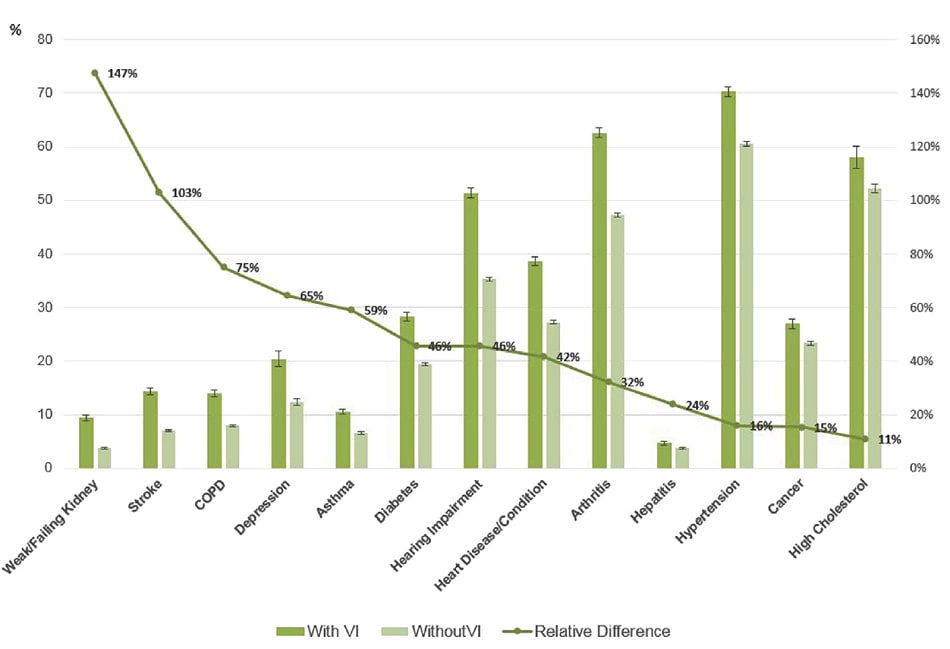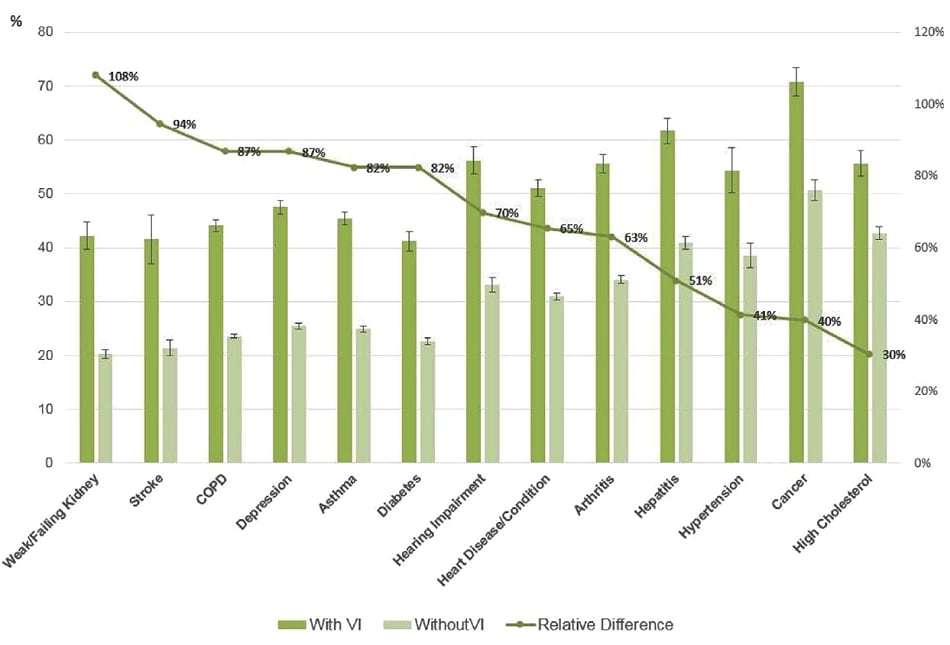Vision Impairment and Chronic Health Conditions
Chronic health conditions are more common among older people with vision impairment than those without vision impairment (VI). Because of the aging US population, the public health burden of vision impairment and chronic diseases is expected to increase.
A recent CDC study1 using data from the National Health Interview Survey (NHIS) revealed that 13.6% of respondents aged 65 years or older reported VI. Additionally, people with VI were more likely to report having some of the 13 chronic conditions examined than people without VI (Table 1). The combination of VI and chronic disease among the older population has serious consequences for overall health, ability to perform tasks, and social participation.
| Unadjusted Model | Adjusteda Model | ||
|---|---|---|---|
| Chronic Condition | Odds Ration for VI vs no VI (95% CI) | ||
| Hypertension | 1.5 (1.4-1.7) | 1.4 (1.3-1.6) | |
| Heart disease | 1.7 (1.6-1.8) | 1.6 (1.5-1.8) | |
| High cholesterol | 1.3(1.1-1.5) | 1.3 (1.1-1.5) | |
| Stroke | 2.2 (1.9-2.5) | 2.0(1.7-2.3) | |
| Arthritis | 1.9 (1.7-2.0) | 1.7 (1.6-1.9) | |
| Asthma | 1.7 (1.5-1.9) | 1.6 (1.4-1.8) | |
| Cancer | 1.2 (1.1-1.3) | 1.2 (1.1-1.4) | |
| Weak/failing kidney | 2.7 (2.3-3.1) | 2.3 (2.0-2.7) | |
| Diabetes | 1.6 (1.5-1.8) | 1.6 (1.4-1.7) | |
| Hepatitis | 1.3 (1.0-1.5) | 1.3 (1.1-1.6) | |
| Depression | 1.5 (1.3-1.9) | 1.5 (1.2-1.8) | |
| Hearing impairment | 2.0 (1.8-2.1) | 1.9 (1.7-2.1) | |
| COPD | 1.9 (1.7-2.1) | 1.6 (1.4-1.9) | |
| CI = confidence interval; COPD = chronic obstructive pulmonary disease; NHIS = National Health Interview Survey. a Adjusted for age, sex, race, education, body mass index, smoking, and physical activity. |
|||
The relative differences in the prevalence of chronic conditions among people with and without vision impairment ranged from 11% higher for high cholesterol to 147% higher for weak or failing kidneys among those with VI.
Figure 1. Prevalence of Chronic Conditions Among People With and Without Vision Impairment (VI), Aged 65 Years
People with vision impairment and chronic conditions reported higher prevalence of fair or poor health, as opposed to good or excellent health, as compared to people without vision impairment, with relative differences ranging from 30% among people with high cholesterol to 108% among people with weak or failing kidneys.
Figure 2. Prevalence of Self-Reported Fair or Poor Health Among People Aged 65 Years or Older Reporting Chronic Conditions, With and Without Vision Impairment (VI)
Findings from this and other studies show that poorer health is associated with chronic conditions among older people with vision impairment. The higher prevalence of chronic conditions among people with vision impairment have important implications for health care, public health, and rehabilitation services.1 For example:
- Vision impairment may hinder stroke rehabilitation.
- Type size of educational materials in chronic disease management programs might be too small for those with vision impairment.
- Vision impairment combined with hearing impairment may lead to a misunderstanding of instructions from medical providers.
- People with vision impairment, especially those who are less educated, that represent ethnic minority groups, and lower socioeconomic status are less likely to access resources and medical care.
This research suggests that the intersection between vision impairment and comorbid conditions is important and may warrant further attention to continue to learn about health disparities and to develop interventions to improve the overall well-being of people with vision impairment and other comorbid chronic conditions.
References
1 Crews, J. E., Chou, C. F., Sekar, S., & Saaddine, J. B. (2017). The Prevalence of Chronic Conditions and Poor Health Among People With and Without Vision Impairment, Aged≥ 65 Years, 2010–2014. American journal of ophthalmology, 182, 18-30.

